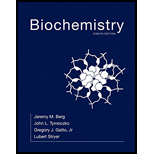
Concept explainers
(a)
Interpretation:
The effect of enzyme mutation on enzyme activity with varying concentrations of carnitine must be determined.
The KM and Vmax values of wild-type and mutant enzymes must be determined.
Concept introduction:
Carnitine palmitoyl transferase I is a mitochondrial enzyme, which forms acyl carnitine by catalyzing the reaction between acyl CoA, and l-carnitine. This allows the transfer of fatty acid chain from cytosol to the mitochondria of the cell. there are three isoforms of CPT I enzyme, CPT1A, CPT1B, and CPT1C.
(b)
Interpretation:
The effect of enzyme mutation on enzyme activity with varying concentrations of palmitoyl CoA must be determined.
The KM and Vmax values of wild-type and mutant enzymes must be determined.
Concept introduction:
Carnitine palmitoyl transferase I is a mitochondrial enzyme, which forms acyl carnitine by catalyzing the reaction between acyl CoA, and l-carnitine. This allows the transfer of fatty acid chain from cytosol to the mitochondria of the cell. there are three isoforms of CPT I enzyme, CPT1A, CPT1B, and CPT1C.
(c)
Interpretation:
The enzyme that is more sensitive to malonyl CoA inhibition must be determined.
Concept introductionCarnitine palmitoyl transferase I is a mitochondrial enzyme, which forms acyl carnitine by catalyzing the reaction between acyl CoA, and l-carnitine. This allows the transfer of fatty acid chain from cytosol to the mitochondria of the cell. there are three isoforms of CPT I enzyme, CPT1A, CPT1B, and CPT1C.
(d)
Interpretation:
Effect of 100 µM palmitoyl CoA, 100 µM carnitine, and malonyl CoA 10µM on mutant enzyme and wild type enzyme must be determined.
Concept introduction:
Carnitine palmitoyl transferase I is a mitochondrial enzyme, which forms acyl carnitine by catalyzing the reaction between acyl CoA, and l-carnitine. This allows the transfer of fatty acid chain from cytosol to the mitochondria of the cell. there are three isoforms of CPT I enzyme, CPT1A, CPT1B, and CPT1C.
(e)
Interpretation:
Role of glutamate 3 in CPTI function should be determined.
Concept introduction:
Carnitine palmitoyl transferase I is a mitochondrial enzyme, which forms acyl carnitine by catalyzing the reaction between acyl CoA, and l-carnitine. This allows the transfer of fatty acid chain from cytosol to the mitochondria of the cell. there are three isoforms of CPT I enzyme, CPT1A, CPT1B, and CPT1C.
Want to see the full answer?
Check out a sample textbook solution
Chapter 22 Solutions
Biochemistry
- Do sensory neurons express ACE2 or only neurolipin-1 receptors for COVID19 virus particle binding?arrow_forwardExplain the process of CNS infiltration of COVID19 through sensory neurons from beginning to end, including processes like endocytosis, the different receptors/proteins that are involved, how they are transported and released, etc.,arrow_forwardH2C CH2 HC-COOO CH2 ܘHO-C-13c-O isocitrate C-S-COA H213c CH2 C-OO 13C-S-COA CH2 C-00 the label will not be present in succinyl CoA C-S-COA succinyl-CoAarrow_forward
- A culture of kidneys cells contains all intermediates of the citric acid cycle. It is treated with an irreversible inhibitor of malate dehydrogenase, and then infused withglucose. Fill in the following list to account for the number of energy molecules that are formed from that one molecule of glucose in this situation. (NTP = nucleotidetriphosphate, e.g., ATP or GTP)Net number of NTP:Net number of NADH:Net number of FADH2:arrow_forward16. Which one of the compounds below is the final product of the reaction sequence shown here? OH A B NaOH Zn/Hg aldol condensation heat aq. HCI acetone C 0 D Earrow_forward2. Which one of the following alkenes undergoes the least exothermic hydrogenation upon treatment with H₂/Pd? A B C D Earrow_forward
- 6. What is the IUPAC name of the following compound? A) (Z)-3,5,6-trimethyl-3,5-heptadiene B) (E)-2,3,5-trimethyl-1,4-heptadiene C) (E)-5-ethyl-2,3-dimethyl-1,5-hexadiene D) (Z)-5-ethyl-2,3-dimethyl-1,5-hexadiene E) (Z)-2,3,5-trimethyl-1,4-heptadienearrow_forwardConsider the reaction shown. CH2OH Ex. CH2 -OH CH2- Dihydroxyacetone phosphate glyceraldehyde 3-phosphate The standard free-energy change (AG) for this reaction is 7.53 kJ mol-¹. Calculate the free-energy change (AG) for this reaction at 298 K when [dihydroxyacetone phosphate] = 0.100 M and [glyceraldehyde 3-phosphate] = 0.00300 M. AG= kJ mol-1arrow_forwardIf the pH of gastric juice is 1.6, what is the amount of energy (AG) required for the transport of hydrogen ions from a cell (internal pH of 7.4) into the stomach lumen? Assume that the membrane potential across this membrane is -70.0 mV and the temperature is 37 °C. AG= kJ mol-1arrow_forward
- Consider the fatty acid structure shown. Which of the designations are accurate for this fatty acid? 17:2 (48.11) 18:2(A9.12) cis, cis-A8, A¹¹-octadecadienoate w-6 fatty acid 18:2(A6,9)arrow_forwardClassify the monosaccharides. H-C-OH H. H-C-OH H-C-OH CH₂OH H-C-OH H-C-OH H-C-OH CH₂OH CH₂OH CH₂OH CH₂OH D-erythrose D-ribose D-glyceraldehyde Dihydroxyacetone CH₂OH CH₂OH C=O Answer Bank CH₂OH C=0 HO C-H C=O H-C-OH H-C-OH pentose hexose tetrose H-C-OH H-C-OH H-C-OH aldose triose ketose CH₂OH CH₂OH CH₂OH D-erythrulose D-ribulose D-fructosearrow_forwardFatty acids are carboxylic acids with long hydrophobic tails. Draw the line-bond structure of cis-A9-hexadecenoate. Clearly show the cis-trans stereochemistry.arrow_forward
 BiochemistryBiochemistryISBN:9781305577206Author:Reginald H. Garrett, Charles M. GrishamPublisher:Cengage Learning
BiochemistryBiochemistryISBN:9781305577206Author:Reginald H. Garrett, Charles M. GrishamPublisher:Cengage Learning Biology: The Dynamic Science (MindTap Course List)BiologyISBN:9781305389892Author:Peter J. Russell, Paul E. Hertz, Beverly McMillanPublisher:Cengage Learning
Biology: The Dynamic Science (MindTap Course List)BiologyISBN:9781305389892Author:Peter J. Russell, Paul E. Hertz, Beverly McMillanPublisher:Cengage Learning Human Heredity: Principles and Issues (MindTap Co...BiologyISBN:9781305251052Author:Michael CummingsPublisher:Cengage Learning
Human Heredity: Principles and Issues (MindTap Co...BiologyISBN:9781305251052Author:Michael CummingsPublisher:Cengage Learning Anatomy & PhysiologyBiologyISBN:9781938168130Author:Kelly A. Young, James A. Wise, Peter DeSaix, Dean H. Kruse, Brandon Poe, Eddie Johnson, Jody E. Johnson, Oksana Korol, J. Gordon Betts, Mark WomblePublisher:OpenStax College
Anatomy & PhysiologyBiologyISBN:9781938168130Author:Kelly A. Young, James A. Wise, Peter DeSaix, Dean H. Kruse, Brandon Poe, Eddie Johnson, Jody E. Johnson, Oksana Korol, J. Gordon Betts, Mark WomblePublisher:OpenStax College BiochemistryBiochemistryISBN:9781305961135Author:Mary K. Campbell, Shawn O. Farrell, Owen M. McDougalPublisher:Cengage Learning
BiochemistryBiochemistryISBN:9781305961135Author:Mary K. Campbell, Shawn O. Farrell, Owen M. McDougalPublisher:Cengage Learning Biology 2eBiologyISBN:9781947172517Author:Matthew Douglas, Jung Choi, Mary Ann ClarkPublisher:OpenStax
Biology 2eBiologyISBN:9781947172517Author:Matthew Douglas, Jung Choi, Mary Ann ClarkPublisher:OpenStax





